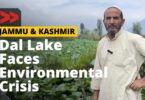Video By: Tahir Mushtaq | Article By: Nusrat Ali
In Ramban the people whose properties are going to be broken down for the creation of dam on Chenab river have been protesting against the unfair compensation being allocated to them by the authorities. This project has received clearance from the Indian environment ministry’s ‘Expert Appraisal Committee for River Valley and Hydroelectric Projects. Sawalkot Hydro Power Project is being constructed by the Jammu and Kashmir State Power Development Corporation (JKSPDC) in District Ramban on river Chenab. It is a state owned project and its power generating capacity is 1856 MW and an amount of $2 billion has been allocated for it.
Residents of 46 villages of District Ramban have to evacuate from their villages. The affected people are worried about their future and rehabilitation. “I appeal administration if they have any such plan, they should first look for our rehabilitation and compensate us so that we do not suffer”, says Vishav Bandu Sharma, a resident of Lower Maitra Ramban.
The Sawalkot project was approved at a meeting held on February 20, 2017. Numerous other hydroelectric projects in Jammu and Kashmir have been proposed by India, all of which faced objection from Pakistan due to the adverse impact it might have on that country. Significantly, the push for the latest project in Jammu seems to have come after India lost 18 soldiers to an armed attack by four Pakistani militants in Uri last September. Does this mean India may now be using water as a weapon against Pakistan? Pakistan is highly dependent on the water from the Indus and its tributaries for its agricultural and domestic purposes. Islamabad fears the Sawalkot dam will reduce the amount of water that flows through this water-stressed country.
Large dams have forced some 40-80 million people from their lands in the past six decades, according to the World Commission on Dams. Those displaced by reservoirs are only the most visible victims of large dams. According to the World Commission on Dams, “The end of any dam project must result in sustainable development of human welfare, that is, it must be economically viable, socially equitable and environmentally sustainable”.
Environmental activists have also voiced their concern over the construction of the dam, which would be tantamount to ecological destruction. There will be a massive displacement of population and the land needed for the dam will sweep away large areas of forest cover.
Moreover, the dam would be highly vulnerable to earthquake being in the seismic zone of Kashmir Himalayas. The site is close to the Himalayan Boundary Thrust zone where a number of earthquakes have been recorded in the past.












